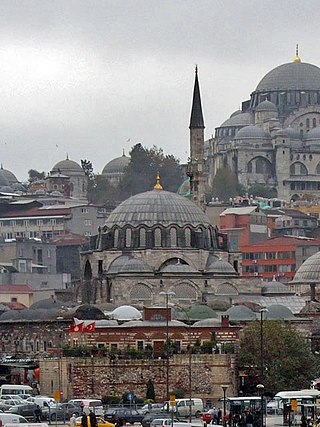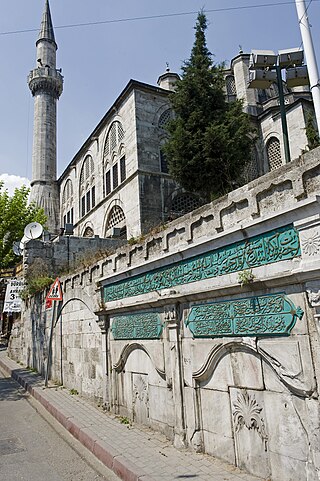
The Süleymaniye Mosque is an Ottoman imperial mosque located on the Third Hill of Istanbul, Turkey. The mosque was commissioned by Suleiman the Magnificent and designed by the imperial architect Mimar Sinan. An inscription specifies the foundation date as 1550 and the inauguration date as 1557, although work on the complex probably continued for a few years after this.
Sedefkar Mehmed Agha or Sedefqar Mehmeti of Elbasan is recorded as the Ottoman architect of the Sultan Ahmed Mosque in Istanbul.

The Rüstem Pasha Mosque is an Ottoman mosque located in the Hasırcılar Çarşısı in the Tahtakale neighborhood of the Fatih district of Istanbul, Turkey, near the Spice Bazaar. Named after Rüstem Pasha, who served as Grand Vizier of the Ottoman Empire under Sultan Suleiman I, it was designed by the Ottoman imperial architect Mimar Sinan and completed in around 1563.

The Selimiye Mosque is an Ottoman imperial mosque, located in the city of Edirne, Turkey. It was commissioned by Sultan Selim II and was built by the imperial architect Mimar Sinan between 1568 and 1575. It was considered by Sinan to be his masterpiece and is one of the highest achievements of Islamic architecture as a whole and Ottoman architecture in particular.

The New Mosque and later New Valide Sultan Mosque after its partial reconstruction and completion between 1660 and 1665, is an Ottoman imperial mosque located in the Eminönü quarter of Istanbul, Turkey. It is situated on the Golden Horn, at the southern end of the Galata Bridge, and is a notable Istanbul landmark marking the crossing from the old historic core of the city to the Beyoğlu (Pera) district. The mosque is a notable example of the Sultanate of Women period in Ottoman Empire.

The Şehzade Mosque is a 16th-century Ottoman imperial mosque located in the district of Fatih, on the third hill of Istanbul, Turkey. It was commissioned by Suleiman the Magnificent as a memorial to his son Şehzade Mehmed who died in 1543. It is sometimes referred to as the "Prince's Mosque" in English. The mosque was one of the earliest and most important works of architect Mimar Sinan and is one of the signature works of Classical Ottoman architecture.

The Yavuz Selim Mosque, also known as the Selim I Mosque and the Yavuz Sultan Selim Mosque is a 16th-century Ottoman imperial mosque located at the top of the 5th hill of Istanbul, Turkey, in the neighborhood of Çukurbostan, overlooking the Golden Horn. Its size and geographic position make it a familiar landmark on the Istanbul skyline.

Sokollu Mehmed Pasha Mosque is a 16th-century Ottoman mosque in the Kadırga neighborhood in Fatih district, Istanbul, Turkey. It was commissioned jointly by the grand vizier Sokollu Mehmed Pasha and his wife İsmihan Sultan. It was designed by the imperial architect Mimar Sinan and completed in 1571/2. The mosque is noted for the fine quality of the Iznik tiles that decorate the interior walls.

The Atik Valide Mosque is a 16th century Ottoman imperial mosque located on a hill above the large and densely populated district of Üsküdar, in Istanbul, Turkey. It was built for Nurbanu Sultan, the wife of Sultan Selim II and formed part of a large complex that included a madrasa, guest-rooms and a double caravanseray. The mosque was designed by the imperial architect Mimar Sinan. Planning began in 1571 for a small mosque with a single minaret. The mosque was subsequently expanded and was not completed until 1586, three years after Nurbanu's death.

The Mihrimah Sultan Mosque is a 16th century Ottoman mosque overlooking the waterfront in the historic center of the Üsküdar district of Istanbul, Turkey. One of Üsküdar's best-known landmarks, it takes its alternative name from the ferry terminal near which it stands. Before the coast road was built, the mosque would have stood right beside the water, accessible by boat.

The Üç Şerefeli Mosque is a 15th-century Ottoman mosque in Edirne, Turkey.

The Zal Mahmud Pasha Mosque is a 16th-century Ottoman mosque located in the Eyüp district of Istanbul, Turkey. It was designed by the imperial architect Mimar Sinan and completed in 1590.

The Kara Ahmed Pasha Mosque or Gazi Ahmed Pasha Mosque is a 16th-century Ottoman mosque near the city walls in Istanbul, Turkey. It was designed by the imperial architect Mimar Sinan and completed in around 1572.

Mesih Mehmed Pasha Mosque is a 16th-century Ottoman mosque in the Fatih district of Istanbul, Turkey. It was commissioned by one of Murad III's grand viziers, Mesih Mehmed Pasha, and designed by the imperial architect Mimar Sinan. The mosque was completed in 1585–86.

The Piyale Pasha Mosque, also known as the Tersane Mosque, is a 16th-century Ottoman mosque located in the Kasımpaşa neighborhood of the Beyoğlu district in Istanbul, Turkey.

The Hadim Ibrahim Pasha Mosque is a 16th-century Ottoman mosque located in the Silivrikapi neighborhood of Istanbul, Turkey.

The Haseki Sultan Complex is a 16th-century Ottoman imperial mosque complex in the Fatih district of Istanbul, Turkey. It was the first royal project designed by the chief imperial architect Mimar Sinan.

The Muradiye Mosque is a 15th-century Ottoman mosque in Edirne, Turkey. The building is noted for the tiles that decorate the mihrab and the walls of the prayer hall.

The Sokollu Mehmed Pasha Mosque is a 16th-century Ottoman mosque located in Istanbul, Turkey.

Classical Ottoman architecture is a period in Ottoman architecture generally including the 16th and 17th centuries. The period is most strongly associated with the works of Mimar Sinan, who was Chief Court Architect under three sultans between 1538 and 1588. The start of the period also coincided with the long reign of Suleiman the Magnificent, which is recognized as the apogee of Ottoman political and cultural development, with extensive patronage in art and architecture by the sultan, his family, and his high-ranking officials.


































